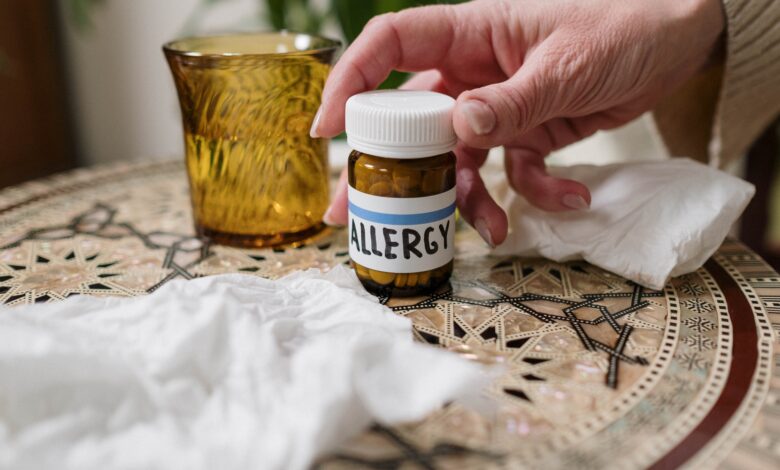
Allergy is an abnormal reaction of the immune system against elements foreign to the body.
To find out more about allergies, see the full information sheet on the subject below.
Allergies: what are they?
Allergy, also called hypersensitivity, is an abnormal reaction of the immune system against elements foreign to the body (allergens), but harmless. It can manifest itself in different regions of the body: on the skin, in the eyes, in the digestive system or in the respiratory tract.
The types of symptoms and their intensity will vary depending on where the allergy occurs, and depending on several other factors specific to each person. They can be very subtle, such as the appearance of redness on the skin, or life-threatening, such as anaphylactic shock.
The main types of allergic manifestations are:
- food allergies;
- asthma, at least in one of its forms, allergic asthma;
- atopic eczema;
- allergic rhinitis;
- certain forms of urticaria;
- anaphylaxis.
People who are allergic are rarely to just one allergen. The allergic reaction can manifest itself in several ways in the same person; allergic rhinitis has been shown to be a risk factor for the development of asthma .
Therefore, a pollen desensitization treatment for hay fever may prevent asthma attacks caused by exposure to these pollens .
The allergic reaction
In most cases, the allergic reaction requires 2 contacts with the allergen.
Awareness
The first time the allergen enters the body, through the skin or through the mucous membranes (eyes, respiratory or digestive tracts), the immune system identifies the foreign element as being dangerous. It starts making specific antibodies against it.
Antibodies or immunoglobulins are substances produced by the immune system. They recognize and destroy certain foreign elements to which the body is exposed. The immune system produces 5 types of immunoglobulins called Ig A, Ig D, Ig E, Ig G and Ig M, which have specific functions. In people with allergies, it is mainly Ig E that are involved.
The allergic reaction
When the allergen enters the body a second time, the immune system is ready to react. Antibodies seek to eliminate the allergen by triggering a set of defense reactions.
The anaphylactic reaction
This allergic reaction, sudden and generalized, affects the whole organism. If not treated quickly, it can progress to anaphylactic shock, i.e. drop in blood pressure, loss of consciousness and possibly death, within minutes.
As soon as the first signs of a serious reaction appear: swelling in the face or mouth, feeling sick, red patches on the body – and as soon as possible before the first signs of respiratory distress appear – difficulty breathing or swallowing, wheezing, change or disappearance of the voice – you must administer epinephrine (EpiPen®, Twinject®) and go to the emergency room as quickly as possible.
atopy
Atopy is a hereditary predisposition to allergies. A person can suffer from several forms of allergies (asthma, rhinitis, eczema, etc.), for unknown reasons.
According to the International Study of Asthma and Allergies in Children, a large study conducted in Europe, 40% to 60% of children with atopic eczema will suffer from respiratory allergies, and 10% to 20 % will have asthma .
The first signs of allergy are often atopic eczema and food allergies, which can appear in infants. Symptoms of allergic rhinitis — sniffles, eye irritation , and nasal congestion — and asthma begin later in infancy .
Allergies: the causes
For there to be an allergy, 2 conditions are essential: the body must be sensitive to a substance, called allergen and this substance must be in the person’s environment.
The most common allergens
Among airborne allergens
Pollen, dust mite droppings and pet dander.
Among the food allergens
Peanuts, cow’s milk, eggs, wheat, soy (soya), tree nuts, sesame, fish, shellfish and sulphites (a preservative).
Other allergens
Medicines, latex, insect venom (bees, wasps, bumblebees, hornets).
Allergic to animal hair?
We are not allergic to hair, but to animal dander or saliva, no more than we are to feathers in pillows and duvets, but rather to the droppings of dust mites that hide there.
We still know little about the origin of allergies. Experts agree that they are caused by a variety of factors. Although there are many cases of family allergies, the majority of children with allergies come from families with no history of allergies .
Therefore, although there is a genetic predisposition, other factors are involved, including: tobacco smoke, Western lifestyle and the environment, including air pollution.
Stress can cause allergy symptoms to appear, but it would not be directly responsible for them.
Milk: allergy or intolerance?
Do not confuse cow’s milk allergy caused by certain milk proteins with lactose intolerance, an inability to digest this milk sugar.
Symptoms of lactose intolerance can be eliminated by consuming lactose-free dairy products or by taking supplements of lactase (Lactaid®), the deficient enzyme, when consuming dairy products.
Allergies: who is affected?
Allergies are much more common today than they were 30 years ago. Worldwide, the prevalence of allergic diseases has doubled over the past 15 to 20 years. From 40% to 50% of the population of industrialized countries is affected by some form of allergy.
In Quebec, according to a report produced by the National Institute of Public Health of Quebec, all types of allergies have experienced a significant increase. The prevalence of allergic rhinitis increased from 6% to 9.4%, asthma from 2.3% to 5% and other allergies from 6.5% to 10.3%.
So what at the beginning of the XX? century, allergic rhinitis affected about 1% of the population of Western Europe, today the proportion of people affected is 15% to 20%.
In some European countries, nearly 1 in 4 children aged 7 or younger has atopic eczema. In addition, more than 10% of children aged 13 and 14 suffer from asthma.
To what can we attribute the progression of allergies?
By observing the social and environmental changes that have marked the last decades, researchers have put forward various hypotheses.
The hygienist hypothesis
According to this hypothesis, the fact of living in an increasingly clean and sanitized environment (homes, places of work and leisure) would explain the increase in the number of cases of allergies in recent decades.
Contact, at a young age, with viruses and bacteria would allow a healthy maturation of the immune system which, otherwise, would tend to allergic reaction. This would explain why children who contract four or five colds a year would be less at risk of allergies.
The permeability of the mucous membranes
According to another hypothesis, allergies are rather the consequence of too great a permeability of the mucous membranes (gastro-intestinal, oral, respiratory) or of a modification of the intestinal flora.
To learn more about the subject, read Allergies: what the experts think.
Allergies: how do they evolve?
Food allergies tend to persist: you often have to ban the food from your diet for the rest of your life. As for respiratory allergies, they can subside to the point of almost completely disappearing, despite the presence of the allergen.
We don’t know why a tolerance can set in, in this case. Atopic eczema also tends to fade over time.
On the contrary, insect venom allergies that occur following stings can worsen, sometimes from the second sting, unless you receive desensitization treatment.
Allergies: how to diagnose them?
The doctor proceeds to a history of the symptoms: at what times, do they appear, and in what way. Skin tests or a blood sample make it possible to precisely discover the allergen in question in order to eliminate it as much as possible from its living environment, and to be able to better treat the allergy.
Skin tests identify the substances that trigger the allergic reaction. They consist of exposing the skin to very small doses of purified allergenic substances; you can test about forty at a time.
These substances can be pollen from various plants, mold, animal dander, dust mites, bee venom, penicillin, etc.
We then observe the signs of an allergic reaction, which can be immediate or delayed (48 hours later, especially for eczema). If there is an allergy, a small red dot appears, similar to an insect bite.








